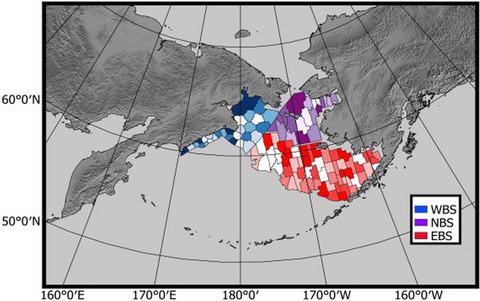当前位置:
X-MOL 学术
›
J. Appl. Ecol.
›
论文详情
Our official English website, www.x-mol.net, welcomes your
feedback! (Note: you will need to create a separate account there.)
Estimating spatiotemporal availability of transboundary fishes to fishery-independent surveys
Journal of Applied Ecology ( IF 5.0 ) Pub Date : 2021-05-17 , DOI: 10.1111/1365-2664.13914 Cecilia A. O’Leary 1, 2 , Stan Kotwicki 1 , Gerald R. Hoff 1 , James T. Thorson 3 , Vladimir V. Kulik 4 , James N. Ianelli 5 , Robert R. Lauth 1 , Daniel G. Nichol 1 , Jason Conner 1 , André E. Punt 2
中文翻译:

为独立于渔业的调查估计跨界鱼类的时空可用性
更新日期:2021-05-17
Journal of Applied Ecology ( IF 5.0 ) Pub Date : 2021-05-17 , DOI: 10.1111/1365-2664.13914 Cecilia A. O’Leary 1, 2 , Stan Kotwicki 1 , Gerald R. Hoff 1 , James T. Thorson 3 , Vladimir V. Kulik 4 , James N. Ianelli 5 , Robert R. Lauth 1 , Daniel G. Nichol 1 , Jason Conner 1 , André E. Punt 2
Affiliation

|
- Taxa can expand beyond historical scientific survey footprints and into new areas with different survey protocols as they move to track their preferred climate. In global groundfish fisheries, for example, scientists estimate population dynamics within the spatial extent of a fishery-independent survey using an index known as a design-based estimator. Observed changes in species distribution in recent years suggest that some groundfish are moving beyond the spatial extent of single surveys. We must intercalibrate disparate data that cover a larger spatial extent to maintain our ability to accurately index populations as their availability to historical surveys changes.
- We combine US and Russian data from the northern, eastern and western Bering Sea to understand the proportion of fish biomass within the extent of the eastern survey (‘availability’). Surveys are within close proximity to each other, but with different sampling protocols (hence catch a different proportion of local densities, termed ‘sampling efficiency ratio’). We use Alaska pollock Gadus chalcogrammus, Pacific cod Gadus macrocephalus and Alaska plaice Pleuronectes quadrituberculatus as case studies to calculate survey efficiency ratios and two area-swept estimators, termed local and conventional, to summarize groundfish biomass over various spatial scales across the Bering Sea.
- We estimated variation in spatial availability of transboundary stocks to the eastern Bering Sea (EBS) survey. In 2017, the most recent available year of survey coverage that included all three Bering Sea regions, estimated availability in the EBS of pollock biomass was ~33%, cod biomass was ~27% and plaice biomass was ~26%, down from ~58%, ~71% and ~30%, respectively, in 2010.
- Synthesis and applications. This is the first study to provide an empirical way to combine Russian and US data in the Bering Sea to assess changes in the availability of groundfish biomass, which, in turn, will alter the interpretations and values of population indices used in regional management. We recommend leveraging this approach using existing global fishery-independent datasets that span different spatiotemporal footprints to monitor transboundary stocks, and as a template to initiate international cooperation on the assessment of spatial availability of stocks common to multiple countries.
中文翻译:

为独立于渔业的调查估计跨界鱼类的时空可用性
- 分类群可以扩展到历史科学调查足迹之外,并随着它们移动以跟踪其首选气候而扩展到具有不同调查协议的新区域。例如,在全球底层鱼类渔业中,科学家使用称为基于设计的估算器的指数来估算独立于渔业的调查空间范围内的种群动态。近年来观察到的物种分布变化表明,一些底层鱼类正在超越单一调查的空间范围。我们必须对覆盖更大空间范围的不同数据进行相互校准,以保持我们准确索引人口的能力,因为它们对历史调查的可用性发生了变化。
- 我们结合了来自北、东和西白令海的美国和俄罗斯数据,以了解东部调查范围内鱼类生物量的比例(“可用性”)。调查彼此非常接近,但采用不同的抽样协议(因此捕获不同比例的局部密度,称为“抽样效率比”)。我们使用阿拉斯加狭鳕Gadus chalcogrammus、太平洋鳕鱼Gadus macrocephalus和阿拉斯加鲽鱼Pleuronectes quadrituberculatus作为案例研究来计算调查效率比和两个区域扫描估计量(称为本地和常规),以总结白令海不同空间尺度上的底层鱼类生物量。
- 我们估计了白令海东部 (EBS) 调查跨界种群空间可用性的变化。2017 年,包括所有三个白令海区域的最近可用调查覆盖年份,估计狭鳕生物量 EBS 中的可用量约为 33%,鳕鱼生物量约为 27%,鲱鱼生物量约为 26%,低于 58 %、~71% 和~30%,分别在 2010 年。
- 合成与应用。这是第一项提供经验方法的研究,以结合俄罗斯和美国在白令海的数据来评估底层鱼类生物量的变化,这反过来将改变区域管理中使用的种群指数的解释和价值。我们建议利用这种方法,利用现有的跨越不同时空足迹的独立于全球渔业的数据集来监测跨界种群,并将其作为启动国际合作评估多个国家共有种群空间可用性的模板。









































 京公网安备 11010802027423号
京公网安备 11010802027423号